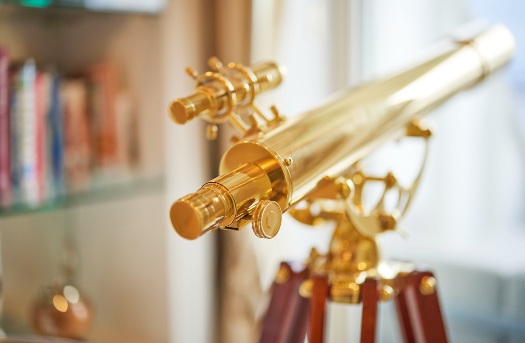Cienfuegos, Cuba
 One of many composite images evoking memories of a visit to Cuba – on the street in Cienfuegos, Cuba
One of many composite images evoking memories of a visit to Cuba – on the street in Cienfuegos, Cuba
Cuba. The name evokes numerous mental images and memories – rum, cigars, music, Hemingway, fishing (“The Old Man and the Sea”), Teddy Roosevelt and the Rough Riders (the Spanish-American War of 1898), Revolution (1959) — Che Guevara and Fidel Castro, American cars of the 1950s, the US – Cuban missile crisis of 1962, Guantanamo, and many more. Given the past strict restrictions on American tourists visiting Cuba, we were very excited when we learned that our ship was planning a visit to Cuba toward the end of 2017. While we were not able to dock in Havana, our trip along the southern coast of Cuba took us to Cienfuegos, Cayo Largo, and Santiago, with an optional three-day overland visit that we took to Havana, between Cienfuegos and Santiago.
Located on Bahía de Cienfuegos, a bay on Cuba’s south coast, Cienfuegos was lovingly nicknamed in colonial times the “Pearl of the South.” A UNESCO World Heritage Site, the capital of the province, Cienfuegos city, is one of the most beautiful villages in Cuba and the only town in Cuba with strong French historical roots and architectural influences. Although the city’s name means “100 Fires,” it was actually named for Don Jose Cienfuegos, the Spanish Captain General who, in 1817, approved a plan to settle French émigrés from Bordeaux and Louisiana in the area. Located 151 miles (244 km) from Havana, the city prospered as a port for sugar and cattle. Today, the city forms two contrasting zones: the colonnaded central zone with its stately Paseo del Prado and graceful park; and Punta Gorda, with its beautiful villas and palaces built by the moneyed classes in the 1920s. The city today has a population of 149,000.
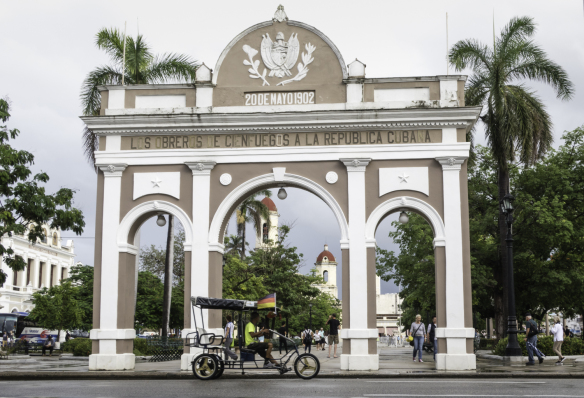 The Arco de Triunfo (Arch of Triumph) at the entrance to Parque José Martí, (also known as the Plaza de Armas) in the Central Zone, a National Monument surrounded by key government and religious structures, is dedicated to the workers of the town and Cuban Independence Day (20 May 1902)
The Arco de Triunfo (Arch of Triumph) at the entrance to Parque José Martí, (also known as the Plaza de Armas) in the Central Zone, a National Monument surrounded by key government and religious structures, is dedicated to the workers of the town and Cuban Independence Day (20 May 1902)
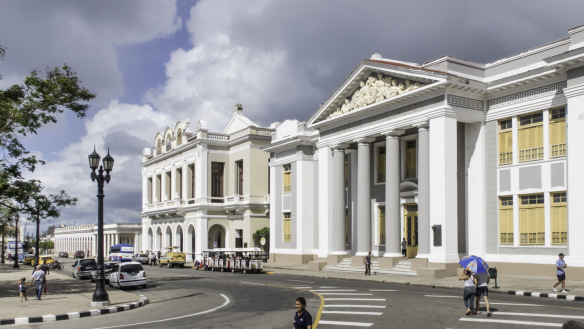 On the north side of Parque José Martí are Teatro Tomas Terry and several historic buildings
On the north side of Parque José Martí are Teatro Tomas Terry and several historic buildings
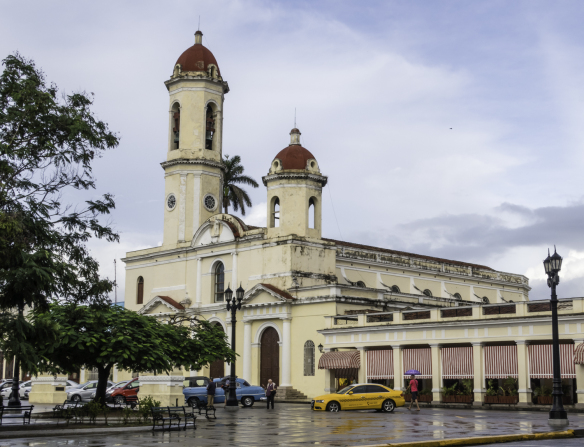 Catedral de la Purisima Concepcion (Holy Church Pure Concepción Cathedral) dates from 1869 and is distinguished by its French stained-glass windows
Catedral de la Purisima Concepcion (Holy Church Pure Concepción Cathedral) dates from 1869 and is distinguished by its French stained-glass windows
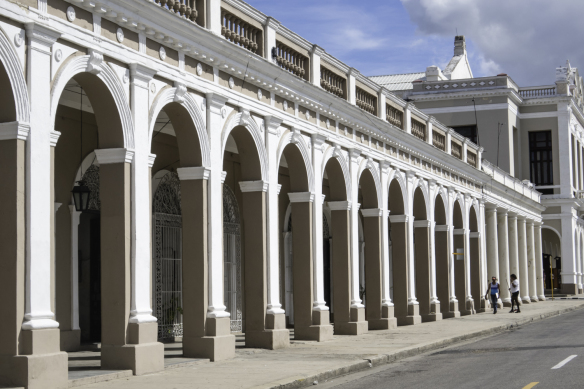 The arcade next to Teatro Tomas Terry, across from Parque José Martí, is now filled with artist studios and galleries
The arcade next to Teatro Tomas Terry, across from Parque José Martí, is now filled with artist studios and galleries
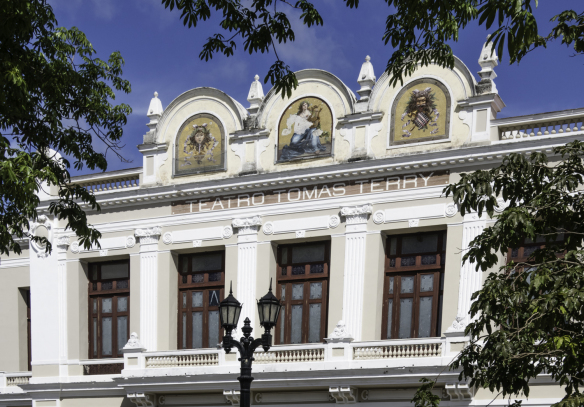 Teatro Tomas Terry, with its gold-leaf mosaics and ceiling frescoes, was built in 1889 and designed for 1,200 people — one of the largest capacity theaters in the Caribbean
Teatro Tomas Terry, with its gold-leaf mosaics and ceiling frescoes, was built in 1889 and designed for 1,200 people — one of the largest capacity theaters in the Caribbean
 Our visit coincided with the end of the rainy season (Hurricane Maria had brushed the island only weeks before our visit), yielding this nice reflection at the edge of Parque José Martí
Our visit coincided with the end of the rainy season (Hurricane Maria had brushed the island only weeks before our visit), yielding this nice reflection at the edge of Parque José Martí
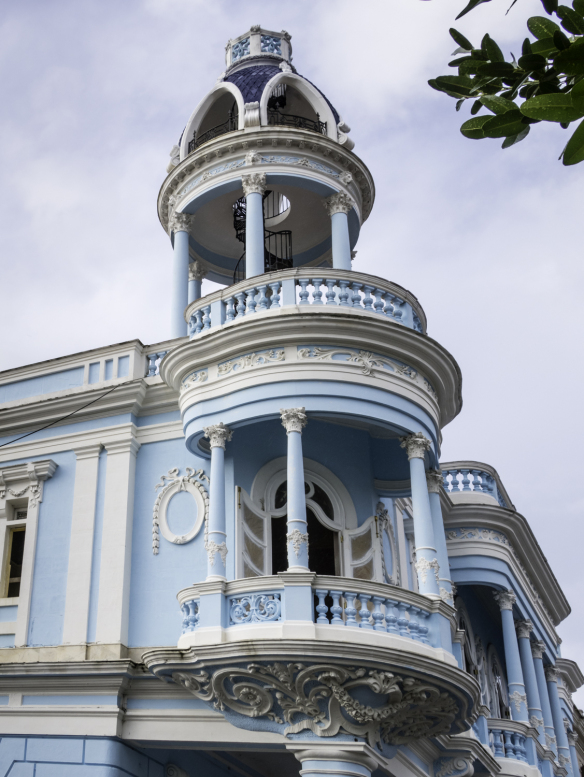 This colonial-era building with a cupola is the structure pictured in the reflection, above
This colonial-era building with a cupola is the structure pictured in the reflection, above
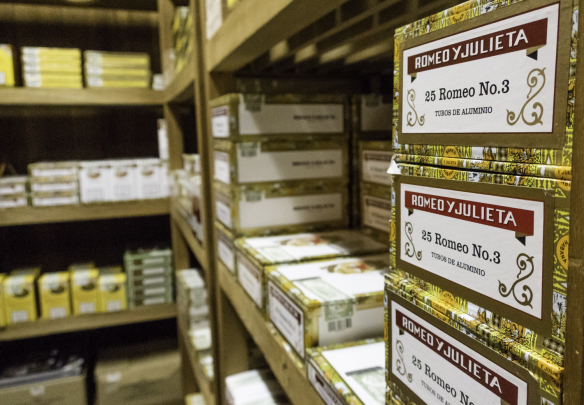 A government-run cigar store across from the Parque José Martí had a great collection of local cigars
A government-run cigar store across from the Parque José Martí had a great collection of local cigars
Ready to learn more?
Determine whether life aboard The World is the right fit for you. Talk to one of our Residential Advisors today to learn more about this unique lifestyle, details of upcoming Journeys and Expeditions, and ownership opportunities.
